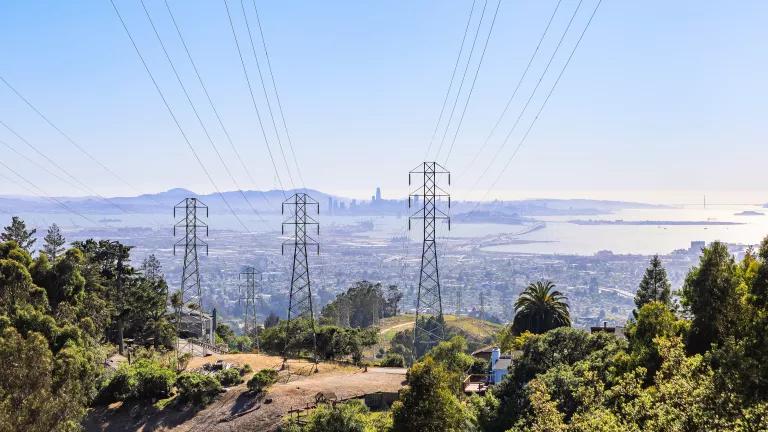Plan for the Grid We Need, Not the Grid We Have
NRDC and other public interest organizations urge FERC to reinvigorate transmission system planning for a new era.

Our power grid is stuck in the 20th century; we are more than two decades overdue for an upgrade. Regional grid operators and utilities in charge of planning are too focused on parochial concerns. The consequences? Clean energy faces enormous barriers, reliability and resilience weaken, costs increase for customers, and fossil power plants keep chugging along.
The primary problem is clear: There’s vast potential to build new wind and solar generation throughout the heart of the nation, but without the transmission lines to bring that power to the population centers hundreds of miles away, it can’t and won’t be built. We need to build these electricity superhighways, but so far, we’ve just been building two-lane local roads.
The Federal Energy Regulatory Commission (FERC), which regulates the high-power transmission grid at a national level, can do a lot to fix this problem. And it’s trying: The Commission recently initiated a new rulemaking to fix these problems. In response, a broad coalition of environmental groups has weighed in with extensive comments detailing the widespread planning failures and the many ways FERC can address them.
We shouldn’t be here; but we are. Ten years ago, FERC issued its landmark grid planning rule Order 1000, which was replete with good intentions: increase regional and interregional grid planning, facilitate state clean energy policies, share costs fairly, and otherwise stimulate the moribund state of grid development. FERC correctly saw the need, but fast forward 10 years, and little has changed.
Order 1000 became mostly a paper compliance exercise. Despite their name, the regional transmission organizations (RTOs) in charge of grid planning for most of the country do very little regional and interregional planning. Outside of the RTOs, such planning is functionally nonexistent. Instead, they just accept local utility proposals to build local transmission, which might be fine to keep the existing power grid running (albeit imperfectly) but does nothing to strengthen our nation’s power system.
A Near-Complete Absence of Regional Planning
Consider the evidence from one of the nation’s largest RTOs, the Midcontinent Independent System Operator (MISO). In the last five years, only 9 out of 2,174 projects approved by MISO have been approved to meet regional system needs.

This failure to plan regionally and beyond has profound impacts. New wind and solar projects simply cannot connect to the grid because it isn’t large enough for the new energy to be injected into the system. When extreme weather knocks out power plants in one area, as the ice and cold did in Texas this winter, or summer storms in Louisiana, the power goes out because the transmission lines don’t exist to move power from other areas where it’s plentiful.
Instead of planning for the grid we need, RTOs and other grid planners charge developers of new energy projects most of the costs of the upgrades necessary for them to safely bring their power onto the system. To use a technical phrase, that’s nuts. It’s like charging the first users of a new highway the complete cost of the road, even though millions of other users benefit from the project. As you might imagine, many energy developers simply cannot afford the high costs, and their projects never get built.
Time for FERC to Act
It’s time to start planning for the grid we need across broad regions of the country. Doing so would cut the costs for connecting new power resources to the grid in nearly half (see this Brattle report at pages 4-5), and all customers would benefit.
The environmental coalition comments to FERC identify many shortcomings in grid planning in most regions of the country and recommend a core set of reforms. They include:
- Strengthen FERC’s oversight of regional grid planning
Robust grid standards mean little if the RTOs and other grid planning regions fall short in practice. FERC can prevent that from happening by creating independent transmission monitors to assess compliance and interregional planning boards to plan upgrades across broader regions. A good example of the need is that most planning regions fail to systematically assess whether fewer large regional projects would better meet system needs than many more local projects. Strong oversight would reduce this unacceptable bias in favor of local projects.
- Require minimum planning standards
Planning only works with robust standards. For example, some transmission projects have many different benefits, such as reducing grid congestion, improving reliability, facilitating state energy goals, and reducing the need for costlier and more polluting generation. Yet most grid regions do not factor most of these benefits against a project’s costs. Consequently, many grid upgrades seem too costly, even when a full accounting of benefits would far outweigh the costs. FERC needs to fix this myopic approach.
FERC also should require grid operators to fully assess high tech solutions to grid problems, especially grid-enhancing technologies and energy storage, both of which can wring out significantly more efficiencies from the existing grid.
- Plan for the future we know is coming
FERC also needs to require grid regions to plan for a wider range of grid needs in the future, and to use more realistic forecasts of future energy demand and renewable energy development. These forecasts need to capture likely increases in wind and solar development driven by the simple fact that these resources are now fully competitive in costs with fossil generation and demand continues to grow. Rising consumer demand for electric vehicles and the overall electrification of our economy, state clean energy standards, and much more is bringing about dramatic changes to what we need the electric grid to do. Planning forecasts must also consider the real effect of climate change on the grid and can’t allow for transmission solutions that exacerbate the problem they claim to solve.
- Plan for interregional grid needs
Grid planners also need to plan for system improvements that span across their regions. Ten years ago, FERC declined to require interregional planning in Order 1000, and the result is virtually no interregional projects. FERC can correct that mistake and require regions to plan together, and to require them to use a single set of planning standards. Importantly, planning also needs to occur across the seam between the Eastern and Western Interconnections to realize some of the highest benefits.

High-Voltage, Direct Current Lines Could Link the Country
- Engage the states
Successful grid planning requires state involvement. State interests include reliability and resilience, siting of new transmission lines, meeting state energy policies, and ensuring an affordable energy supply. If their citizens are being asked to pay for a portion of transmission built outside their state, the state leaders need to understand the value of those investments. Engaging states early and often will only help.
Transmission Benefits All Users of the Grid
Our proposed solutions benefit all users of the power grid, including those who don’t have strong preferences for renewable energy. A well-designed electrical system improves the overall efficiency of the grid and reduces the costs of power generation. Transmission also can aggregate consumer electricity demand from across broad areas. Since different regions experience different peak power demands, due to time of day, climate, and weather, transmission allows peak demand to be met with less generation – improving the resilience of the grid and saving consumers’ money.
With its new initiative, FERC is taking a key step toward meeting its legal responsibility to build the grid we need, not simply re-build the grid we already have. It is also heartening that FERC has announced its aim to better incorporate environmental justice and equity concerns into the Commission’s decision-making processes. These same considerations must be incorporated into the transmission planning and generator interconnection processes.
With our proposed reforms, FERC can start to get ahead of the ongoing transformation of our nation’s power system, one that will be cleaner, more reliable and lower cost. That’s something we all should be able to agree upon.



